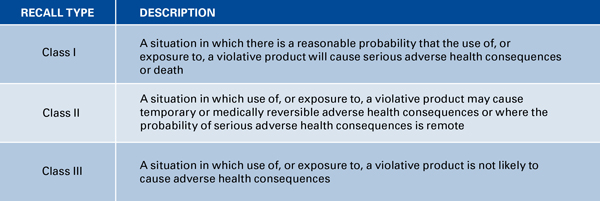Recall: The Food Industry's Biggest Threat to Profitability
Our goal is to share insights about the key issues facing security and supply chain practitioners in food, beverage and other ingestible product industries.
Here, we will explore the food industry’s biggest threat to profitability. We will discuss the key predictors of costs in a food recall, identify the common causes of recalls and propose some pathways to prevent or mitigate the cost of recalls.
 Food Recall Impact
Food Recall Impact
The number of food recalls in the U.S. has shown a dramatic increase in the last few years, jumping four-fold over the number just 5 years ago.
There are multiple reasons for the huge spike in the number of recalls, but contributing factors include the increasingly global and complex food supply chain, a few dramatic, large scale recalls, such as intentional shipment of Salmonella-contaminated peanut products by the Peanut Corporation of America and the recall of over a half billion fresh eggs from Wright County Egg and Hillandale Farms, and the resulting heightened regulatory oversight and media coverage of an issue that directly impacts public health.
 Food recalls are most importantly a public health issue, but they are also significant economic issues. The average cost of a recall to a food company is $10M in direct costs, in addition to brand damage and lost sales according to a joint industry study by the Food Marketing Institute and the Grocery Manufacturers Association. However the costs for larger brands may be significantly higher based on the preliminary recall costs reported by firms of some recent recalls.
Food recalls are most importantly a public health issue, but they are also significant economic issues. The average cost of a recall to a food company is $10M in direct costs, in addition to brand damage and lost sales according to a joint industry study by the Food Marketing Institute and the Grocery Manufacturers Association. However the costs for larger brands may be significantly higher based on the preliminary recall costs reported by firms of some recent recalls.
 And these are just the direct costs, which typically include notification (to regulatory bodies, supply chain, consumers), product retrieval (reverse logistics), storage, destruction, unsalable product, and of course, the additional labor costs associated with these activities as well as the investigation of the root cause. They do not include what could arguably be the more significant costs to the company from litigation costs, the costs from any agreed or mandated governmental oversight post incident, lost sales, and the impact to the company’s market value and brand reputation. Today's consumer cannot help but be aware of food recalls with the 24×7 media coverage and the power of social networking to both spread the news and influence the brand. In a Harris Interactive poll, consumers indicated that 55% would switch brands temporarily following a recall, and 15% said they would never purchase the recalled product and 21% would avoid purchasing any brand made by the manufacturer of the recalled product. A 2010 U.S. Grocery Supplier survey seems to validate these intentions. In the year following the large spinach and peanut butter recalls, almost three-quarters of consumers stopped purchasing those products out of safety concerns, dropping to one-quarter in the second year.
And these are just the direct costs, which typically include notification (to regulatory bodies, supply chain, consumers), product retrieval (reverse logistics), storage, destruction, unsalable product, and of course, the additional labor costs associated with these activities as well as the investigation of the root cause. They do not include what could arguably be the more significant costs to the company from litigation costs, the costs from any agreed or mandated governmental oversight post incident, lost sales, and the impact to the company’s market value and brand reputation. Today's consumer cannot help but be aware of food recalls with the 24×7 media coverage and the power of social networking to both spread the news and influence the brand. In a Harris Interactive poll, consumers indicated that 55% would switch brands temporarily following a recall, and 15% said they would never purchase the recalled product and 21% would avoid purchasing any brand made by the manufacturer of the recalled product. A 2010 U.S. Grocery Supplier survey seems to validate these intentions. In the year following the large spinach and peanut butter recalls, almost three-quarters of consumers stopped purchasing those products out of safety concerns, dropping to one-quarter in the second year.
While there is limited information on the true costs of recall to the food industry, it is important to gain an understanding of the direct financial impact on your company. Is there a formula for calculating these costs?
 In December 2010, researchers Moises Resende-Filho and Brian Burr proposed a model that may be a quick and useful thumbnail sketch to individual firms estimating the direct impact of a food recall. The model is based on a breakdown of the total consumer expenditure on farm food, taking into account the cost and quantity of the affected product. Using a base number of $661.1B, the team found $537.88 attributable to marketing cost, including $75.68 for advertising and transportation. Using advertising as a proxy for recall notification, and transport as a proxy for transport costs during a recall, the team derived that approximately 4% of food marketing cost could be applied to advertising recall notification. Transport was applied to 10% of food marketing cost. Hence, they proposed the following baseline:
In December 2010, researchers Moises Resende-Filho and Brian Burr proposed a model that may be a quick and useful thumbnail sketch to individual firms estimating the direct impact of a food recall. The model is based on a breakdown of the total consumer expenditure on farm food, taking into account the cost and quantity of the affected product. Using a base number of $661.1B, the team found $537.88 attributable to marketing cost, including $75.68 for advertising and transportation. Using advertising as a proxy for recall notification, and transport as a proxy for transport costs during a recall, the team derived that approximately 4% of food marketing cost could be applied to advertising recall notification. Transport was applied to 10% of food marketing cost. Hence, they proposed the following baseline:
Using this formula, if the “Universal Grains Corporation” recalls 285,000 boxes of “Crunchy Flakes” breakfast cereal, and the average retail cost per box is $4.29, the minimum expected direct cost would be $1,393,821. However, the nature of a food recall often requires additional actions and costs. After the contaminated Crunchy Flakes have been retrieved from the market, the product will need to be destroyed. Universal Grains may require additional labor or warehouse space to stage and destroy the product. Depending on what kind of contaminant compromised the cereal, the manufacturer may have to complete the recall under hazardous materials rules, requiring specially trained personnel. In addition, Universal Grains will want to determine the root cause of the contamination, and will likely expend additional resources in conducting an investigation.
Food Recall Causes
Clearly, regulatory scrutiny has significantly elevated the probability of a recall and the economic impact of a recall can be higher than any company can afford to bear. Unfortunately, almost every enterprise class food manufacturer, processor, and distributor has experienced the challenge of a recall. Major contributing factors to recent recalls have been deficiencies in the food production and monitoring processes such as non-compliance with current Good Manufacturing Practices (GMPs), failure to maintain food processing facilities and equipment, non-compliance with their own Standard Operating Procedures, weaknesses in their Hazard Analysis and Critical Control Points (HACCP) analysis and inability to track products through their supply chain.
Researchers at Queen's University, Belfast completed the first ever analysis of all the food recalls announced in the USA, UK and Ireland over the last decade. The research by Dr. Antony Potter at Queen’s Centre for Assured and Traceable Foods identified 2,439 food recalls over the past ten years and found that only 21% were detected by the company in question, whereas 68% were detected during routine or spot testing by regulatory bodies. Dr. Potter said, “Most recalls (56%) resulted from operational mistakes, such as incorrect labeling, the presence of an undeclared ingredient, or contamination during the production process. While biological causes, such as the detection of Listeria, Salmonella and Escherichia coli were also factors, a significant number of food safety alerts were actually due to food fraud and corruption by suppliers further down the supply chain. This highlights the need for food producers to invest in ensuring the traceability of their products back through the supply chain.”
Does Traceability Offer Hope?
To an individual firm, the value of traceability is the ability to differentiate and sell its product after a competitor has delivered unsafe food to the marketplace.
To an industry, traceability is essential to the protection of the industry’s collective reputation and market share by isolating products from the source of the problem.
To the consumer, traceability means identifying contaminated products before she serves them to her family. On a macro scale, the collective consumer interest is tantamount to public health.
But how do you establish how much a firm, an industry, or consumers should be willing to pay to achieve traceability in its supply chain? Well, that’s going to vary with the risk tolerance of the stakeholders involved. However, an examination of adverse consequences, including recalls and public health cost, provides us with powerful information on the cost of failure. In August 2006, more than 200 consumers in 26 states fell ill and five died after eating E. coli-tainted spinach. On September 14, 2006, The U.S. Food and Drug Administration advised consumers not to consume bagged spinach. Subsequent investigations of the incident failed to yield a means of contamination. Estimates of direct losses from the 8-day recall ranged from $37 to $74M. One year later, the spinach industry reported a 20% reduction in sales and a $350M loss. In this case, an entire industry was held accountable for the lapse.
In an undifferentiated market, an individual firm's investment in food protection is diluted among all firms in its industry. Good actors and bad actors all suffer the same outcome. In this environment, the firms that invest the most in preventive controls and traceability actually suffer the deepest losses in crisis.
When recall strikes in an undifferentiated marketplace, buyers cannot distinguish sellers of good product from sellers of contaminated product. This results in consumer avoidance of an entire category of products, and can severely impact a whole industry rather than the individual firm(s) responsible. But what would happen if the source and distribution footprint could have been identified through improved traceability?
Would the market reward firms not implicated in a recall? Could culpable firms limit their losses through increased investments in traceability? According to at least one study, the answers are yes and yes. And the savings may be significant. In a simulation modeled on the contamination of one day's production at a ground beef processor, where product was assumed to have reached the consumer, and shelf life was set at 14 days, perfect traceability limited the mean projected loss by more than 90% In the same simulation, with shelf life set at 28 days, the mean projected loss was limited by more than 95%.
Preventing Recalls
Traceability can be an effective solution to mitigate risk when a recall occurs, but are there practices that can be effective in preventing a recall from happening in the first place? Since the majority of recalls happen due to operational mistakes, a commitment and adherence to meeting one of the highest global food safety standards recognized by the Global Food Safety Initiative (GFSI) can be the best defense against food recalls. Standards such as BRC, SQF, and ISO 22000 all share a common foundation in sound food safety management practices, such as GMPs and HACCP. Companies that achieve certifications in these world-class standards demonstrate that they have implemented and audited sound food safety principles and typically exhibit key characteristics that set them apart, such as:
• Make meaningful divisions to maintain batch integrity
• Perform frequent, thorough cleaning and sanitation processes
• Maintain effective HACCP programs, and learn from “near misses" as well as actual occurrences
• Have an established, practiced communications protocol and current, accurate escalation trees
• Document, document, document
• Validate, validate, validate
• Prepare, Practice and Drill: Train, and make sure everyone in the value chain, including OEM and 3PL partners, understand the rules and are held to the same standards
• Plan ahead, anticipating what information will be required by stakeholders, and keep it segregated from other records
In addition to these preventive measures, best-in-class companies intelligently apply technology to address key certification requirements. For example:
• Certified standards include requirements to strictly define and control access points for employees and visitors, which should include particularly vulnerable areas to tampering such as mixing, or ingredient preparation. Active RFlD technology can help control access even in wide-open plant areas where traditional card access technologies are impractical.
• Certified companies are expected to adhere to personal hygiene principles, to document infractions, and through continuous improvement processes, ensure that they do not happen again. Remote video auditing technology can be deployed to view and audit practices, and send specific video clips of infractions for training purposes, to ensure compliance to these practices at all plants, globally.
Employing these best practices can help prevent recalls from happening in the first place, but of course, can't guarantee that it never will. But if a recall is necessary, deploying these practices is also the best defense in any future lawsuit. And according to legal experts, a defendant who follows the safe food handling requirements and has documentation to prove it is more likely to be found to have exercised “reasonable care” and control to prevent contamination and has a stronger defense than companies that don't.
A Better Plan
An effective food defense strategy is not simply a requirement to follow federal mandates but is a proactive strategy to prevent the potential for significant costs to the business from an ineffective program. History tells us that the market's penalty always exceeds the direct costs of a recall. Research tells us that a majority of the reason for recalls are due to operational deficiencies. Nevertheless, recent studies suggest that traceability may provide needed incentives for individual firms to be rewarded for effective delivery of safe foods to the market and intelligent application of technology can help prevent recalls from happening.
Learn more at www.tycois.com
Looking for a reprint of this article?
From high-res PDFs to custom plaques, order your copy today!






